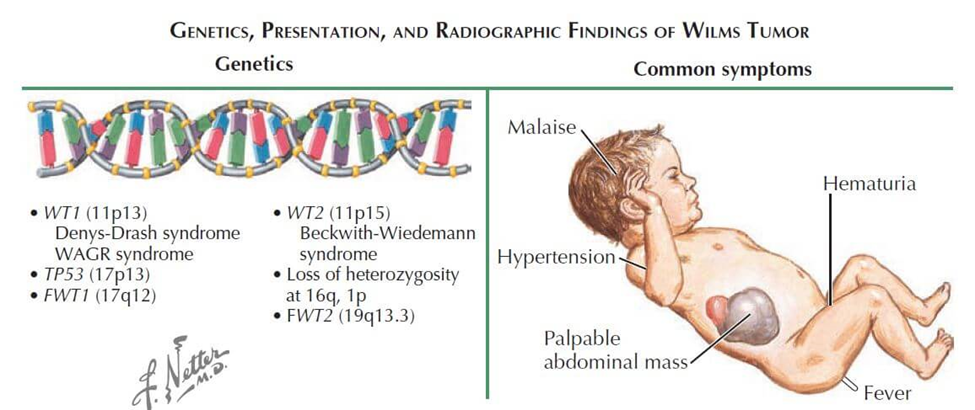A child is diagnosed with Wilms' tumor. During assessment, the nurse in charge expects to detect:
Gross hematuria
Dysuria
An abdominal mass
Nausea and Vomiting
The Correct Answer is C
A. Gross hematuria: Gross hematuria refers to visible blood in the urine, which can present as pink, red, or cola-colored urine. While hematuria can be associated with various kidney conditions, including Wilms' tumor, it is not a consistent or defining symptom of this specific tumor. Additionally, because the tumor is typically confined within the kidney and does not usually invade the urinary tract, gross hematuria might not always be present.
B. Dysuria: Dysuria is the medical term for painful or difficult urination. It is not a typical symptom of Wilms' tumor, as this tumor primarily affects the kidney and may not directly affect the urinary tract in a way that causes painful urination.
C. An abdominal mass: This is the correct answer. Wilms' tumor often presents as a palpable abdominal mass, which may be felt during physical examination. The mass is usually firm, non-tender, and confined to one side of the abdomen. Detection of an abdominal mass should prompt further diagnostic evaluation to confirm the diagnosis and plan appropriate treatment.
D. Nausea and vomiting: While some children with Wilms' tumor may experience nausea and vomiting, these symptoms are nonspecific and can be caused by various conditions. They are not considered characteristic or defining features of Wilms' tumor. The presence of nausea and vomiting would prompt further assessment to determine the underlying cause

Nursing Test Bank
Naxlex Comprehensive Predictor Exams
Related Questions
Correct Answer is D
Explanation
A. Eczema: Eczema is a chronic skin condition characterized by inflammation, redness, and itching. It is not typically caused by bacterial infections and does not present with signs around the mouth and nose.
B. Vitiligo: Vitiligo is a condition characterized by the loss of skin color in patches. It is not caused by bacterial infections and does not typically present with signs around the mouth and nose.
C. Angioedema: Angioedema is swelling beneath the skin, often around the eyes and lips, and is commonly associated with allergic reactions or other triggers. It is not caused by bacterial infections.
D. Impetigo: Impetigo is a bacterial skin infection caused by Staphylococcus aureus or Streptococcus pyogenes bacteria. It commonly presents with red sores or blisters around the mouth and nose, especially in children and the elderly. Therefore, option D, Impetigo, is the correct answer.
Correct Answer is D
Explanation
A. Patches of baldness: Patches of baldness on the scalp could be indicative of conditions like alopecia areata, a disorder characterized by hair loss in patches. However, it is not a typical manifestation of pediculosis capitis, which primarily presents with scalp itchiness due to lice bites rather than hair loss.
B. Blisters on the scalp: Blisters on the scalp may suggest other conditions such as herpes simplex infection or contact dermatitis. While scratching from head lice infestation could lead to skin irritation, blisters are not a common presentation of pediculosis capitis.
C. Dry patches on the scalp: Dry patches on the scalp might be caused by conditions like seborrheic dermatitis or eczema. While scalp dryness can occur with pediculosis capitis due to irritation from scratching, it is not a specific symptom associated with head lice infestation.
D. Reports of scalp itchiness: Scalp itchiness is a hallmark symptom of pediculosis capitis. It occurs as a result of lice bites and the body's inflammatory response to their saliva. It is the most characteristic and common manifestation of head lice infestation and often prompts further examination for the presence of lice or their eggs (nits).
Whether you are a student looking to ace your exams or a practicing nurse seeking to enhance your expertise , our nursing education contents will empower you with the confidence and competence to make a difference in the lives of patients and become a respected leader in the healthcare field.
Visit Naxlex, invest in your future and unlock endless possibilities with our unparalleled nursing education contents today
Report Wrong Answer on the Current Question
Do you disagree with the answer? If yes, what is your expected answer? Explain.
Kindly be descriptive with the issue you are facing.
